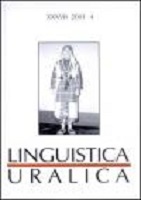Leisten die Baltismen in den ostseefinnischen Sprachen einen Beitrag zur Klärung der Entwicklungsetappen von balt. *ei?
Can the Baltic Loanwords in Finnic Languages Clarify the Stages of Development of the Baltic Diphthong *ei?
Author(s): Lembit VabaSubject(s): Finno-Ugrian studies, Baltic Languages
Published by: Teaduste Akadeemia Kirjastus
Keywords: Finnic languages; Baltic languages; historical phonetics; sound substitution; loanwords
Summary/Abstract: I believe that the Baltic loanwords detected in Finnnic languages can indeed shed some light on the still somewhat unclear history of the Baltic vowel system. The ancient Baltic diphthong ei persists in the extinct Prussian and (partly) in the Curonian language. The ei-words of the Samogitian dialect of Lithuanian, however, represent an older layer of the Curonian substrate. The Baltic diphthong ie is not a Proto-Baltic heritage, but a relatively recent innovation. However, there is no consensus on the phonetic history of ie as a common Latvian and Lithuanian innovation. According to one view, the Lithuanian and Latvian diphthong ie derived from the Proto-Baltic *ei diphthong only after the East Baltic languages had separated from the West Baltic ones, assuming that *ei was first monophthongized into a midhigh long closed *ē, which was later diphthongized into ie. The assumption enjoys wide support among Balticists. My article suggests that the Proto-Baltic intermediary monophthong *ē may be traced in some Baltic loanwords eventually identified as such in Estonian and Finnish: East Baltic *ē > Finnic ē > Est ē (in front-vowel stems) resp. Liv, Est ȭ (in back-vowel stems), Liv, Fin ie: (1) Late Finnic *ēla(s) ’row’ < East Baltic *ēlā: Latv ìela, Lith eilà, eilẽ ’row etc.’; (2) Late Finnic *mēlo1 ’transom, pole’ < East Baltic *mē + *-lo-: Latv miels ’flight board of a beehive’; (3) Late Finnic *mēlo2 ’bride’s presents to wedding guests’ < East Baltic *mēla-: Lith mielúoti, Latv mielât, miẽluôt ’treat, entertain, feed’; (4) Late Finnic *nētä- ’to swear, to curse’ < East Baltic *nēd-: Lith níedėti ’detest, hate, despise, humiliate’. The words analysed belong to the Southern Finnic language group, while case (4) also occurs in West Finnish dialects, which can be regarded as indirect evidence of it belonging to a somewhat more recent layer of Baltic loanwords, compared to those reflecting the Baltic *ei diphthong. Increased attention to the possible monophthongous intermediary *ē of the Proto-Baltic ei diphthong could well have a heuristic role in identifying new Baltic etymologies, which could possibly contribute to our understanding of the development stages of the ie diphthong, which is a common Baltic innovation, yet still an object of debate.
Journal: Linguistica Uralica
- Issue Year: LII/2016
- Issue No: 1
- Page Range: 26-31
- Page Count: 6
- Language: German

